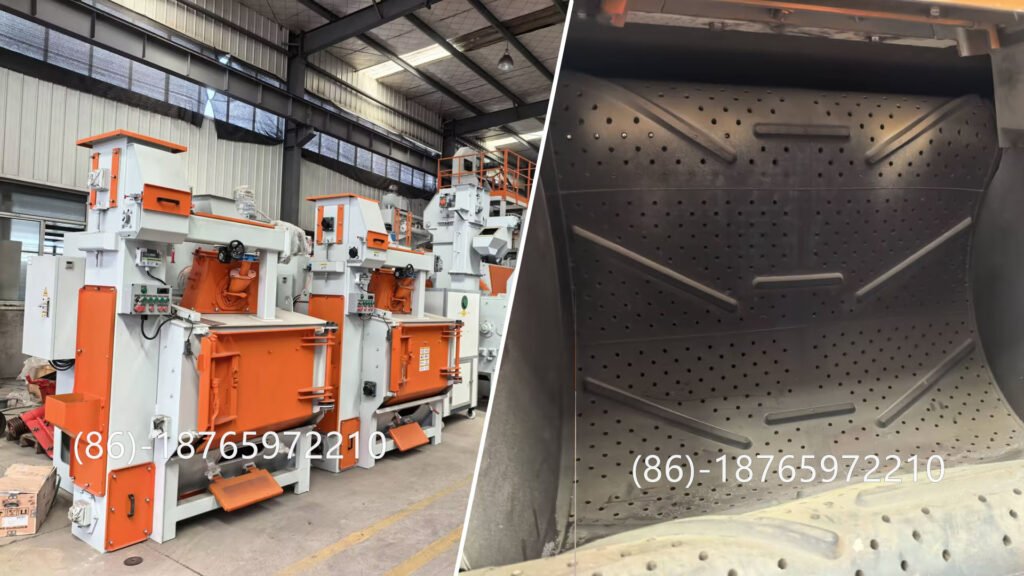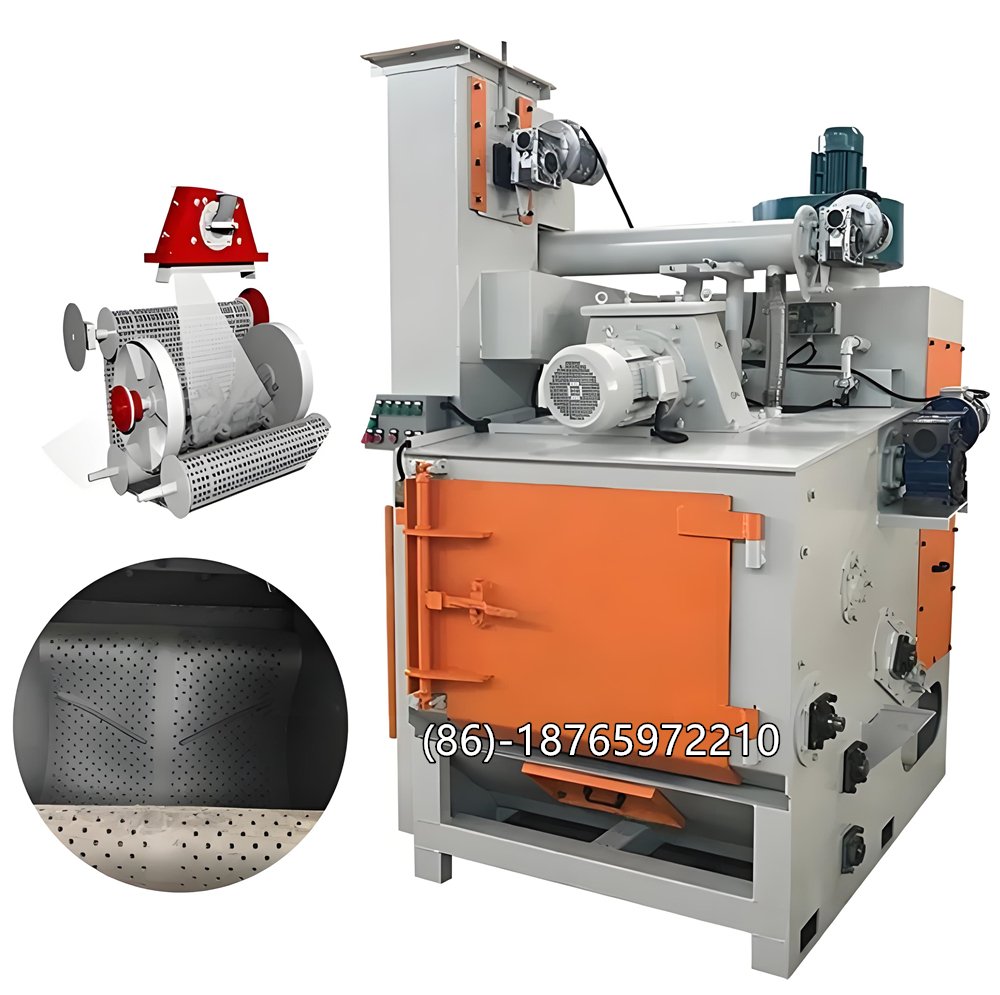About Tumble Belt Shot Blasting Machine
Tumble belt shot blasting machine is a common surface treatment machine widely used in foundries, automotive, forging, and small to medium-sized metal parts below 40kg production. It is designed to clean, descale, or strengthen bulk workpieces by blasting them with high-speed abrasive.
Working Principle and Operation
Working Principle
- Workpieces are loaded into a rubber or steel belt drum.
- When the drum rotates, parts tumble over each other, exposing all surfaces.
- Blast wheels throw steel shot or grit at high speed onto the moving parts.
- Impact removes rust, scale, and sand, leaving a clean, roughened surface.
- Abrasive falls through the drum openings, collected and recycled via elevator and separator.
- Dust and fine particles are drawn into the dust collector, keeping the system clean.

Tumble Belt Shot Blasting Machine Operation
(I) Machine Operation:
- Operate this machine only after you have a comprehensive understanding of its working principles, performance, operation methods, and lubrication.
- Gradually add 200kg of shot into the chamber, then place the workpiece. Close the loading door and prepare to start the machine.
- Start the dust collector fan.
- Press the buttons to start the elevator, shot blast wheel, and shot feed gate in sequence to begin cleaning. After cleaning is complete, press the buttons to close the shot feed gate, shot blast wheel, elevator, and dust collector fan in sequence. Then, start the vibrating motor to clean the dust. After a certain period of time, the vibrating will stop.
- After the shot blast wheel has completely stopped, open the loading door and lift out the workpiece and workpiece.
- In an emergency, press the emergency stop button to immediately stop all operations.
- After all operations are completed, close the dust collector immediately.
- The ventilation and dust removal system is equipped with two butterfly valves. Adjust the two butterfly valves according to the situation to achieve the best separation effect.
- Adjust the directional sleeve of the shot blast wheel.
- This shot blasting machine has three shot speeds. Changing the shot blasting speed can be accomplished by changing the shot blasting machine motor pulley. The replacement steps are as follows:
First, turn off the shot blasting machine and the main power supply. After the shot blasting machine has come to a complete stop, loosen the motor fastening bolts and remove the V-belt. Then, use a hexagonal wrench to loosen the pulley fastening bolts. Use three M12 bolts to push the tapered bushing apart from the pulley and remove the pulley. Fit the desired pulley to the tapered bushing and press it into the motor shaft. Then, tighten the three M10 pulley fastening bolts with a hexagonal wrench. Install the V-belt. Finally, use the jackscrew to push the motor into position and tighten the bolts to secure the motor. Important: The outer end face of the motor pulley should be flush with the outer end face of the shot blasting machine pulley. If not, loosen the three M10 pulley fastening bolts and adjust the position.
The three shot speeds correspond to the two hoist lift capacities. The hoist motor sprocket installation and adjustment procedures are the same as above. 11. This machine has a manual pill separator. During normal operation, the manual pill separator is in the feed-on, discharge-off positions, supplying pills to the electromagnetic pill separator. To discharge, simply flip the manual pill separator handle to the opposite position. Note that the handle must be secured in place with the bolts for both discharge and feed operations. - After one week of operation, open the inspection door at the lower front of the chamber to remove any large pieces of material from the screen plate. Check the screen plate for wear and replace it if necessary.
(II) Notes for Attention:
- Regularly remove dust from the dust collection box below the dust collector to prevent clogging of the dust exhaust pipe and affecting dust removal efficiency.
- Regularly clean debris from the bottom of the cleaning chamber and under the screen in the separator hopper.
- Regularly sweep the shot around the equipment to prevent slipping and injury.
- Regularly check the crawler and elevator belts in the cleaning chamber for deviation to avoid belt damage.
- Do not open the loading door when the shot blaster is not fully stopped to prevent accidents.

Maintenance and Common Issues
Routine Maintenance
- Daily
- Inspect blast wheel sound and vibration.
- Check drum belt/links for cracks or wear.
- Remove accumulated shot around door seals.
- Weekly
- Inspect and replace worn wheel blades or liners.
- Clean dust filter bags or cartridges.
- Verify separator screen is not clogged.
- Monthly
- Check drive chains, tension, and lubrication.
- Inspect wear plates inside blast chamber.
- Calibrate abrasive flow adjustment.
- The wear-resistant protective plates in the cleaning room can be replaced regularly according to the degree of wear. When replacing the protective plates, the installation gap between the plates should be controlled within 2 millimeters.
Common Issues & Troubleshooting
- Uneven cleaning → batch overloaded, or shot flow reduced.
- Excessive dust leakage → door seal worn or dust collector weak.
- Unusual noise from blast wheel → blade wear or imbalance, stop and inspect immediately.
- Abrasive carryover → separator adjustment needed.
Engineer’s Note
Regular inspection of blast wheel components and belt condition saves costly downtime. A short stop for preventive replacement is always cheaper than an unplanned breakdown.

